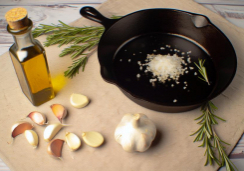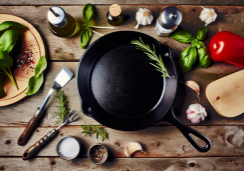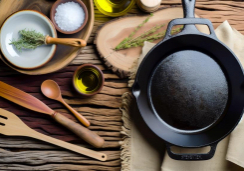12 Simple Stir-Fry Methods for Healthy Eating
In the realm of healthy eating, stir-frying stands at the crossroads of nutritional value and culinary delight, allowing you to savor the best of both worlds. You've likely heard that this cooking technique can be a cornerstone of a balanced diet, but you may not know just how simple it can be to infuse your meals with both flavor and nourishment.
With a few key ingredients and the right approach, you can transform the humblest vegetables and leanest proteins into a feast for the senses. As you explore these 12 simple stir-fry methods, you'll uncover how to make each dish not only a testament to healthy eating but also a celebration of quick and delicious home cooking.
So, what's the secret to unlocking the full potential of your skillet or wok, ensuring your stir-fries are as beneficial to your health as they are pleasing to your palate? Stay tuned, as the answer might just revolutionize your dinner routine.
Choose Lean Proteins
Selecting lean proteins such as chicken, tofu, or shrimp is a cornerstone of crafting a healthier stir-fry. These options provide high-quality nutrients without the added baggage of excessive fats. Specifically, firm tofu can be a game-changer; it's not only rich in protein but also has a satisfying texture that holds up well to the high heat of stir-frying.
When you opt for lean cuts of meat, you're making a conscious decision to reduce the overall fat content of your meal. It's a simple switch that can have a big impact on your health. To crank up the flavor without cranking up the calorie count, consider marinating these proteins in zesty, low-fat sauces. Doing so infuses them with taste so you won't miss any of the fat that's left out.
While veggies are vital, balancing them with an ample amount of lean proteins ensures your stir-fry is nutritious and filling. This approach helps sustain energy levels and supports muscle growth and repair. Remember to use just enough oil to cook your proteins; it's all about keeping things light.
After you've cooked your veggies, add the protein back into the pan to meld the flavors together—this is when your stir-fry truly comes to life.
Opt for Healthy Oils
While you've focused on lean proteins, it's equally important to consider the type of oil you use, as the right choice can elevate the health benefits of your stir-fry. Opting for healthy oils such as olive oil or sesame oil not only reduces saturated fats but also increases heart-healthy fats in your meal. These oils aren't just flavorful; they're packed with nutrients that are good for your heart.
Moreover, it's wise to choose oils with high smoke points, like avocado oil or coconut oil, to prevent the formation of harmful compounds that can occur during high-heat stir-frying. These oils ensure that you're cooking safely and healthily. Prioritize oils rich in monounsaturated and polyunsaturated fats, such as canola oil or peanut oil, to promote better cholesterol levels and overall heart health.
Don't be afraid to experiment with different flavored oils, like chili-infused or garlic-infused oils, to add depth to your dishes. This way, you avoid dishes that are high in sodium while still enhancing the taste. And remember, the key is moderation. Use minimal amounts of oil to keep the calorie and fat content low, ensuring your stir-fry remains a healthy part of your diet.
Incorporate Colorful Vegetables
To boost both the visual appeal and nutritional content of your stir-fry, incorporate a vibrant array of vegetables like bell peppers, broccoli, carrots, and snow peas.
Sliced bell peppers add not just a pop of color but also a sweet, slightly smoky flavor that complements other ingredients beautifully.
Bright orange carrots offer a delightful crunch and are packed with beta-carotene, which is essential for maintaining good vision.
Toss in some broccoli florets for a satisfying texture and a dose of valuable nutrients like vitamin C and potassium.
Don't overlook the crispness of snow peas; they bring a fresh, mild sweetness to your dish and are a great source of fiber and vitamins.
Experimenting with different combinations of these colorful vegetables won't only add a variety of flavors and textures to your stir-fry but also ensure you're getting a diverse range of antioxidants, vitamins, and minerals.
By aiming to incorporate a rainbow of colors, you're setting up your stir-fry to be as nutritionally balanced as it's visually appealing.
This method of adding colorful vegetables not only enhances the dish's visual allure but also promotes overall health and wellness.
Keep your meals exciting and your body nourished with every vibrant bite.
Master the Stir-Fry Sauce
Crafting the perfect stir-fry sauce is key to elevating your dish, allowing you to tailor flavors to your taste and ensuring a healthier meal. Don't hesitate to experiment with different stir-fry sauce variations to find what delights your palate.
Start with a base of soy sauce, which brings a rich umami flavor, and consider using a low-sodium version or tamari if you're watching your salt intake or need a gluten-free option.
To thicken your sauce and give it that velvety texture that clings to your ingredients, mix a bit of cornstarch with cold water before adding it to your stir-fry. This step is crucial for achieving the right consistency without relying on premade sauces that may be high in sugar or preservatives.
For a zestier, more refreshing twist, incorporate citrus-based sauces such as lemon or lime, which cut through the richness and add a bright note. Lean towards natural ingredients and lighter alternatives like coconut aminos or rice vinegar to craft a homemade stir-fry sauce that's both tasty and better for you.
Control the Heat
Mastering the art of heat control is essential for a stir-fry that's cooked to perfection, ensuring your ingredients are seared beautifully without burning. The key to this is understanding when to crank up the heat and when to dial it down.
Here's how you can navigate the temperature like a pro:
- High Heat:
- Ideal for searing proteins and quick-cooking veggies.
- Use a hot pan, skillet, or wok to achieve that appetizing char.
- Lower Heat:
- Perfect for simmering sauces or finishing up those delicate ingredients.
- Prevents overcooking and retains the vibrant colors of your veggies.
Prepare Ingredients Ahead
Before you fire up the wok, let's explore the art of mise en place, the French culinary concept of having everything in its place.
You'll learn how to pre-cut your ingredients for maximum flavor and efficiency, and how to store them so they're ready to toss into the pan at a moment's notice.
Mise En Place Basics
To ensure your stir-fry turns out both delicious and nutritious, start by preparing all your ingredients—protein, vegetables, aromatics, and sauce—ahead of time for a seamless cooking experience. Embracing the mise en place basics not only streamlines your cooking process but also preserves the flavors and nutrients of your dish. Here's how to master the prep:
- Mise En Place Basics
- *Protein*: Slice into even pieces for consistent cooking.
- *Vegetables*: Chop, dice, or julienne, keeping similar textures together.
- *Aromatics*: Mince garlic, ginger, and onions; they'll infuse your stir-fry with flavor.
- *Sauce*: Mix ingredients in a bowl; have it ready to pour.
This method reduces stress and minimizes the risk of overcooking. Follow these steps to execute your stir fry recipes flawlessly every time.
Ingredient Pre-Cutting Tips
While preparing your stir-fry, ensure all ingredients—from crunchy vegetables to tender proteins—are pre-cut to facilitate a swift and effortless cooking experience. Follow these ingredient pre-cutting tips for an efficient session in the kitchen.
Slice your veggies uniformly, not just for even cooking, but for a dish that's as pleasing to the eye as it's to the palate. When it comes to proteins, cut them into thin strips or bite-sized chunks to ensure they cook through quickly and evenly.
Store your pre-cut components in separate containers to keep them fresh and at your fingertips when it's time to fire up the wok. By preparing ingredients ahead, you're setting the stage for a seamless stir-fry that's both healthy and hassle-free.
Efficient Storage Solutions
Maximize your stir-fry efficiency by pre-cutting and storing your ingredients in airtight containers, ensuring they're ready to go when you are. By preparing ahead, you'll save precious time and make cooking with your skillet or large skillet a breeze. Here's how to stay organized:
- Pre-Cutting and Storing:
- Vegetables and proteins: Keep them fresh in airtight containers.
- Stir-fry sauces: Portion and refrigerate for grab-and-go ease.
- Longer-Term Storage:
- Freezer-safe bags: Ideal for bulk prep and extended freshness.
- Labeling: Date your ingredients to avoid waste and use them at their peak.
Invest in quality containers designed for meal prepping, and you'll find stir-frying healthier meals isn't just quick—it's a pleasure.
Utilize Aromatic Spices
Unlock the full potential of your stir-fry by selecting aromatic spices like cumin, coriander, and cinnamon. These spices not only boost flavor but also bring health benefits to the table.
You'll notice a significant enhancement in taste when you toast these spices before adding them to your dish.
Fresh herbs such as basil and cilantro can also elevate the aroma and freshness of your stir-fry. They give it a unique and personalized touch.
Spice Selection Benefits
Infusing your stir-fry with aromatic spices not only boosts its flavor and aroma but also enhances its health benefits. These potent ingredients make healthy eating easy and delightful. Here's why:
- Flavor and Aroma
- Depth and complexity: Aromatic spices add layers to your stir-fry, making every bite interesting.
- Sensory appeal: The enticing scents make your meal an experience, not just sustenance.
- Health Benefits
- Nutritional boost: Spices like turmeric and ginger offer anti-inflammatory properties.
- Unique profiles: Mixing spices allows for a range of healthy, delicious combinations.
Embrace these spice selection benefits to turn your simple stir-fry into a gourmet, health-forward dish. Enjoy the process of creating meals that are as nutritious as they're aromatic.
Aromatics Flavor Enhancement
Building on the nutritional benefits of spices, incorporating aromatic spices like garlic, ginger, and green onions can significantly elevate the flavor profile of your stir-fry. Start by infusing your oil with these aromatics to create a fragrant base.
Don't shy away from experimenting with warming spices such as cumin, coriander, and a hint of cinnamon to add depth. A splash of wine vinegar can balance the richness with a subtle tang, marrying well with the sharpness of green onions.
Fresh herbs like cilantro or basil bring a final burst of freshness, making your dish vibrant. Remember, the quantity of these aromatics is in your hands; adjust to your taste, ensuring your stir-fry is a custom-crafted delight for your palate.
Stir-Fry in Batches
To ensure your stir-fry is cooked evenly and retains its vibrant texture, start by cooking in small batches to avoid overcrowding the pan. Using a large wok or skillet, crank up the heat to sear your ingredients quickly, sealing in flavors and nutrients.
Here's how to make the most out of batch cooking:
- Protein First
- Sear meat or tofu until just done; set aside.
- Don't let pieces touch too much; they need space to brown.
- Veggies Next
- Begin with the hardy ones like carrots and broccoli.
- Add tender vegetables like baby bok choy towards the end.
Keep Ingredients Moving
As you master the art of stir-frying, keep the dance of ingredients lively in the pan to ensure they cook uniformly and stay crisp. The key to a successful stir-fry isn't just the high heat but the constant motion.
Remember to stir quickly and easily; your spatula becomes an extension of your hand, moving the ingredients around the pan in a swift, rhythmic motion. This quick and easy technique helps to prevent sticking and burning, giving each piece the perfect texture and flavor.
To maintain this finesse, stir-fry in small batches. It's tempting to throw everything in at once, but overcrowding the pan will lead to uneven cooking and a less desirable outcome. Instead, introduce ingredients in stages, keeping each batch moving until it's just right.
When it's time to add the sauce, do so at the right moment to prevent sogginess. A well-timed pour followed by a vigorous stir ensures that your dish is evenly coated and bursting with flavor. Plus, this constant movement isn't just about taste – it helps retain the bright colors and essential nutrients of your vegetables, making your stir-fry as nourishing as it's delicious.
Serve With Whole Grains
You've mastered the stir-fry technique, so let's enhance your meal with whole grains like brown rice or quinoa. These grains aren't just a hearty base; they boost your dish with extra fiber and essential nutrients.
We'll explore the best pairings and how to cook these grains to perfection, ensuring your stir-fry is both delicious and nourishing.
Whole Grain Benefits
Incorporating whole grains into your stir-fry dishes not only adds a hearty texture but also infuses your meal with a spectrum of essential nutrients that bolster overall health.
Here's why you should serve your vibrant stir-fries with whole grains like brown rice:
- Whole Grain Benefits:
- Fiber content aids digestion and weight management.
- B vitamins and minerals support bodily functions.
Whole grains can be a game changer for your health. They're known to reduce the risk of chronic diseases such as heart disease, diabetes, and certain cancers. Plus, their ability to promote a feeling of fullness means you're likely to stay satisfied longer, helping you manage your energy levels throughout the day.
Grain Pairing Suggestions
Building on the benefits of whole grains, consider brown rice or quinoa to enhance your stir-fry with an extra layer of fiber and essential nutrients. These whole grain options not only complement the flavors and textures of your healthy stir-fry but also contribute to a satisfying and balanced meal. Food and nutrition experts often recommend pairing such grains with your stir-fries to round out the dish, providing a heartier experience that doesn't compromise on health.
The wholesome goodness of whole grains offers a filling backdrop to the vibrant veggies and lean proteins in your stir-fry. By choosing these grains, you're ensuring that each bite is packed with nutritional value, making your meal both delicious and nourishing.
Cooking Whole Grains
Mastering the art of cooking whole grains is a simple yet effective way to elevate your stir-fry dishes with both taste and nutrition. To make a healthy and delicious stir-fry, serve it with a side of perfectly cooked whole grains. Here's how to do it right:
- Rinse your grains:
- Removes excess starch
- Clears away debris
- Cook with the right ratio:
- Typically, 1:2 (grain to water).
- Quinoa, brown rice, farro
- Enhance their flavor:
- Toast in a dry skillet before cooking
- Boost taste without the salt:
- Use low-sodium broth instead of water
- Variety is key:
- Try bulgur, barley, wild rice
- Adds nutritional benefits
These steps will ensure your grains are a perfect complement to your stir-fries.
Flavor With Fresh Herbs
To elevate your stir-fry, toss in fresh herbs like cilantro, basil, or mint for an instant flavor boost. These vibrant additions not only heighten taste but also infuse your meal with an enticing aroma that can't be matched by dried spices. Imagine the crispness of snow peas mingling with the lushness of basil – it's a combination that will make your taste buds sing.
Experiment with different herb combinations to discover new and exciting profiles that will enliven your dishes. For instance, cilantro pairs wonderfully with the heat of ginger and garlic, while mint can offer a refreshing counterpoint to the richness of sesame oil.
Remember to add your fresh herbs towards the end of the cooking process. This ensures they retain their bright colors and full-bodied flavors, which are vital for that final, flavorful punch. Using herbs as a garnish also adds a visual pop that makes your dish as appealing to the eye as it's to the palate.
If you're keen on having the freshest flavors possible, why not start your own herb garden? This way, you'll always have a supply of fresh herbs on hand, ready to transform your next stir-fry into a delectable masterpiece.
Can I Use the Same Stir-Fry Methods for Healthy Eating and Healthy Cooking?
Yes, you can absolutely use the same simple healthy stirfry methods for both healthy eating and cooking. Stir-frying allows you to cook with minimal oil, while still retaining the nutrients in the vegetables. It’s a quick, flavorful, and healthy way to prepare meals.
Practice Portion Control
While infusing your stir-fry with fresh herbs enhances flavor, it's also important to manage how much you eat by practicing portion control. Smaller plates can trick your mind into feeling satisfied with less, and measuring your ingredients ensures each meal is balanced. Be particularly mindful of how much sauce you add; it's easy to overdo it, which can lead to consuming more calories and sodium than intended. Opt for a light drizzle of sauce or use chicken broth as a healthier, flavorful alternative.
Here are some tips to help you keep your portions in check:
- Use smaller plates and bowls:
- A visual cue to eat less.
- Encourages you to take smaller servings.
- Measure servings:
- Proteins: A serving about the size of a deck of cards.
- Grains: Aim for a half-cup, cooked.
- Vegetables: Fill half your plate.
Eating slowly and mindfully allows you to tune into your body's fullness signals. Chew thoroughly and savor each bite. And when you're ready to dish out your stir-fry, use these strategies to keep your portions reasonable. This way, you can enjoy your meal without overindulging.
Conclusion
Now that you're armed with these stir-fry secrets, you'll whip up nutritious feasts in no time. Remember to pick lean proteins, heart-healthy oils, and a rainbow of veggies for maximum benefits. Keep that heat high, but don't stop moving those ingredients!
Pair with whole grains, brighten with herbs, and always measure your portions. Mastering the art of stir-fry not only fuels your body right but also adds a dash of culinary flair to your healthy eating routine.
Cook on!










